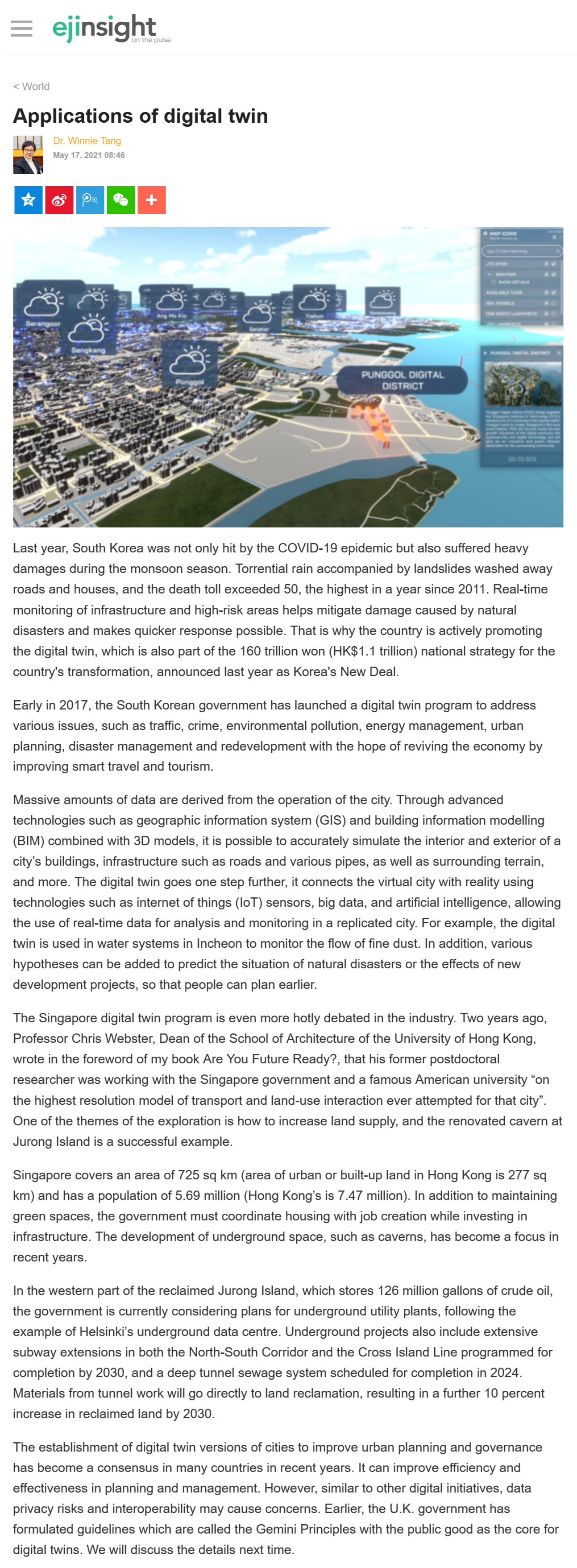網上版請按此

Applications of digital twin
Last year, South Korea was not only hit by the COVID-19 epidemic but also suffered heavy damages during the monsoon season. Torrential rain accompanied by landslides washed away roads and houses, and the death toll exceeded 50, the highest in a year since 2011. Real-time monitoring of infrastructure and high-risk areas helps mitigate damage caused by natural disasters and makes quicker response possible. That is why the country is actively promoting the digital twin, which is also part of the 160 trillion won (HK$1.1 trillion) national strategy for the country's transformation, announced last year as Korea's New Deal.
Early in 2017, the South Korean government has launched a digital twin program to address various issues, such as traffic, crime, environmental pollution, energy management, urban planning, disaster management and redevelopment with the hope of reviving the economy by improving smart travel and tourism.
Massive amounts of data are derived from the operation of the city. Through advanced technologies such as geographic information system (GIS) and building information modelling (BIM) combined with 3D models, it is possible to accurately simulate the interior and exterior of a city's buildings, infrastructure such as roads and various pipes, as well as surrounding terrain, and more. The digital twin goes one step further, it connects the virtual city with reality using technologies such as internet of things (IoT) sensors, big data, and artificial intelligence, allowing the use of real-time data for analysis and monitoring in a replicated city. For example, the digital twin is used in water systems in Incheon to monitor the flow of fine dust. In addition, various hypotheses can be added to predict the situation of natural disasters or the effects of new development projects, so that people can plan earlier.
The Singapore digital twin program is even more hotly debated in the industry. Two years ago, Professor Chris Webster, Dean of the School of Architecture of the University of Hong Kong, wrote in the foreword of my book Are You Future Ready?, that his former postdoctoral researcher was working with the Singapore government and a famous American university "on the highest resolution model of transport and land-use interaction ever attempted for that city". One of the themes of the exploration is how to increase land supply, and the renovated cavern at Jurong Island is a successful example.
Singapore covers an area of 725 sq km (area of urban or built-up land in Hong Kong is 277 sq km) and has a population of 5.69 million (Hong Kong's is 7.47 million). In addition to maintaining green spaces, the government must coordinate housing with job creation while investing in infrastructure. The development of underground space, such as caverns, has become a focus in recent years.
In the western part of the reclaimed Jurong Island, which stores 126 million gallons of crude oil, the government is currently considering plans for underground utility plants, following the example of Helsinki's underground data centre. Underground projects also include extensive subway extensions in both the North-South Corridor and the Cross Island Line programmed for completion by 2030, and a deep tunnel sewage system scheduled for completion in 2024. Materials from tunnel work will go directly to land reclamation, resulting in a further 10 percent increase in reclaimed land by 2030.
The establishment of digital twin versions of cities to improve urban planning and governance has become a consensus in many countries in recent years. It can improve efficiency and effectiveness in planning and management. However, similar to other digital initiatives, data privacy risks and interoperability may cause concerns. Earlier, the U.K. government has formulated guidelines which are called the Gemini Principles with the public good as the core for digital twins. We will discuss the details next time.
Dr. Winnie Tang
Adjunct Professor, Department of Computer Science, Faculty of Engineering; Department of Geography, Faculty of Social Sciences; and Faculty of Architecture, The University of Hong Kong